#Fungi of Britain
Explore tagged Tumblr posts
Video
Love is...An Alien Fungus that smells of Corpses... by Will Atkins Via Flickr: This Devil's Fingers Fungus (Clathrus archeri) seems to be trying to communicate a message of peace and love...
#Devil's Fingers#Devil's Fingers Fungus#Clathrus#Clathrus archeri#Heart#Love#Fungus#Fungi#European Fungi#British Fungi#UK Fungi#Hampshire Fungi#New Forest Fungi#New Forest#New Forest wildlife#Fungi of Britain#Fungi of the UK#Fungi of Hampshire#Fungi of Europe#Fungi of the New Forest#Heathland#Mushroom#Toadstool#Toadstools#Alien Species#alien wildlife#Non-native species#non-native wildlife#Nikon#Nature
39 notes
·
View notes
Text
oh how tangible the difference between pre- and post- clocks shifting back to winter time is. i don’t care how edgy not-like-other-girls this makes me sound, i truly am a creature of the autumn. a dweller in the wind and rain. at home in the misty evenings and the creeping chill, dry orange leaves blanketing the footpaths. muddy fields and slate-grey overcast skies. i was born in november. my mother, nine months pregnant with me, silent in her womb like a stone, went wandering through the woods and found a beautiful plump round bolete mushroom, standing proud and alone. a few days later i came into the world. she told me i was born under the sign of that mushroom. a child of the damp eerie darkness, i suppose, burrowing from underground, severed cruelly from the collective slimy embrace of the mycelium. i live in raincoats and scarves now, wander through the local cemetery in the cold. it’s not lonely. the mushrooms are out
#ivy.txt#me#not poetry not NOT poetry i suppose#fungi#autumn#november#october#halloween#cringe culture is dead#autism#strange britain
12 notes
·
View notes
Text










Sunny view at Loch Ruthven in Scotland in May, Grey Silverfish at home last night, view at Milkham in the New Forest on Saturday, phone photos of views at Winchester Cathedral and at the Weirs and periwinkle in Winchester today and Snow Bunting and parasol at Sandy Point, Hayling Island on Sunday.
Blue Tit, Long-tailed Tit, Carrion Crow, House Sparrow, daisy, hemp agrimony seed heads and privet berries were also nice to see today.
#photography#privet#parasol#snow bunting#loch ruthven#sandy point#hayling island#winchester#fungi#2024#outdoors#england#scotland#uk#britain#europe#world#earth#nature#november#autumn#spring#periwinkle
5 notes
·
View notes
Text

Silky ink cap
Yorkshire, England
16 notes
·
View notes
Text
The Rotten World About Us (Video, 1980)
You can watch this British TV documentary here.






#tw fungi#cw fungi#tw mushrooms#cw mushrooms#tw decay#cw decay#tw rotting#cw rotting#tw infection#cw infection#tw mold#cw mold#internet archive#video#videos#documentary#documentaries#uk#britain#england#1980#1980s#80s#1980's#80's#fungus#fungi#mushroom#mushrooms#mold
7 notes
·
View notes
Text
Common sunburst lichen (Xanthoria parietina) photo I took recently, West Yorkshire, UK

#nature#nature photography#lichen#lichens#fungi#fungus#fungiphotography#fungi photography#sunburst#wild#wild photography#wild planet#flora#british nature#uk nature#britain#uk#beautiful#pretty#fiery#photography#photo#photos
5 notes
·
View notes
Video
European robin (Erithacus rubecula) sitting on a tree stump, by Adam Swaine Via Flickr: Beautiful little bird was so near taken on 55mm setting was taking pictures of tits turned around and he was almost on my shoulder..
#fungi#woodland#woods#lichen#perching#passerine bird#passerines#mirrorless#BTO#RSPB#Old World flycatcher family#Old World flycatchers and chats#(Old World flycatchers)#adult robin (Erithacus rubecula)#Robin (Erithacus rubecula)#woodland robins#robins#robin#robin red breast#(European) Robin#Birds#little birds#garden birds#england#english#english birds#british birds#british#britain#wildlife
1 note
·
View note
Text
Animal of the Day!
Dwarf Cassowary (Casuarius bennetti)
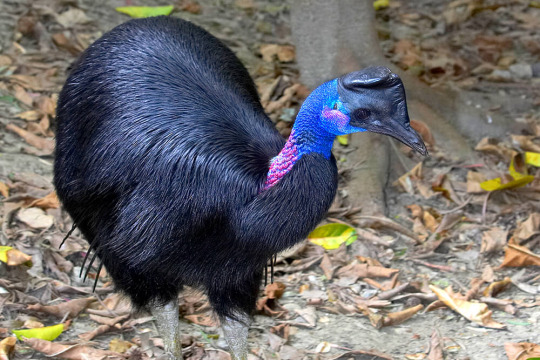
(Photo from San Diego Zoo)
Conservation Status- Least Concern
Habitat- New Guinea; New Britain; Yapen Island
Size (Weight/Length)- 25 kg; 150 cm
Diet- Leaves; Carrion; Fungi; Small mammals
Cool Facts- The dwarf cassowary, also called the muruk, is the smallest of the cassowary species alive today. Despite their small size, dwarf cassowary still sport a dagger claw on their inner foot that can be up to 9 centimeters long. As with many birds, female cassowaries are larger due to needing to carry up to 8 eggs at a single time. After the eggs are laid, the female peaces out and leaves the male to raise their offspring as one of the best single dads in the animal kingdom. It’s his job to teach the chicks how to forage and hunt. Due to governmental protection, dwarf cassowary have increased in number as hunting decreases.
Rating- 11/10 (Yes, their blush is natural.)
#animal of the day#animals#birds#cassowary#tuesday#december 19#dwarf cassowary#biology#science#conservation#the more you know
184 notes
·
View notes
Text
what's up ! non-exhaustive list of stories featuring weird plants :
The Day of the Triffids, John Wyndham
The Night of the Triffids, Simon Clark
In the Tall Grass, Stephen King and Joe Hill
The Boats of the 'Glen Carrig', William Hope Hodgson
The Man Whom the Trees Loved, Algernon Blackwood
The Red Tree, Caitlín R. Kiernan
Annihilation, Jeff VanderMeer
The Willows, Algernon Blackwood
The Nature of Balance, Tim Lebbon
'Bloom', John Langan
The Ruins, Scott Smith
The Wise Friend, Ramsey Campbell
'The Green Man of Freetown', The Envious Nothing : A Collection of Literary Ruins, Curtis M. Lawson
The Beauty, Aliya Whiteley
The Ash-Tree, M.R. James
Canavan's Backyard, J.P. Brennan
Invasion of the Body Snatchers, Jack Finney
The Hollow Places, T. Kingfisher
'Reaching for Ruins', Crow Shine, Alan Baxter
'Vortex of Horror', Gaylord Sabatini
Hothouse, Brian W. Aldiss
Vaster than Empires and More Slow, Ursula K. Le Guin
Odd Attachment, Ian M. Banks
Deathworld #1, Harry Harrison
The Bridge, John Skipp and Craig Spector
'The Garden of Paris', Eric Williams
Apartment Building E, Malachi King
The Seed from the Sepulchre, Clark Ashton Smith
Rappaccini's Daughter, Nathaniel Hawthorne
The Nursery, Lewis Mallory
The Other Side of the Mountain, Michel Bernanos
The Vegetarian, Han Kang
Sisyphean, Dempow Torishima
The Root Witch, Debra Castaneda
Semiosis, Sue Burke
The Wolf in Winter, Charlie Parker #12, John Connolly
Perennials, Bryce Gibson
Relic, Douglas Preston and Lincoln Child
Gwen, in Green, Hugh Zachary
The Voice in the Night, William Hope Hodgson
Ordinary Horror, David Searcy
The Family Tree, Sheri S. Tepper
The Book of Koli, Rampart Trilogy #1, M.R. Carey
Seeders, A.J. Colucci
Concrete Jungle, Brett McBean
The Plant, Stephen King
Anthologies/collections :
The Roots of Evil: Weird Stories of Supernatural Plants, edited by Michel Parry
Chlorophobia: An Eco-Horror Anthology, edited by A.R. Ward
Roots of Evil: Beyond the Secret Life of Plants, edited by Carlos Cassaba
The Green Man: Tales from the Mythic Forest, edited by Ellen Datlow and Terri Windling
Sylvan Dread: Tales of Pastoral Darkness, Richard Gavin
Evil Roots: Killer Tales of the Botanical Gothic, edited by Daisy Butcher
Weird Woods: Tales From the Haunted Forests of Britain, edited by John Miller
'But fungi aren't plants' :
The Fungus, Harry Adam Knight
Growing Things and Other Stories, Paul Tremblay
The Girl with All the Gifts, M.R. Carey
Mexican Gothic, Silvia Moreno-Garcia
Fruiting Bodies, and Other Fungi, Brian Lumley
'The Black Mould', The Age of Decayed Futurity, Mark Samuels
What Moves the Dead, T. Kingfisher
The House Without a Summer, DeAnna Knippling
Mungwort, James Noll
Fungi, edited by Orrin Grey and Silvia Moreno-Garcia
Trouble with Lichen, John Wyndham
Notes :
all links lead to the goodreads page of the book, mostly because i like to look at book cover art ;
list features authors/books that i love (T. Kingfisher, Silvia Moreno-Garcia, Ursula K. Le Guin, the collections from the British Library Tales of the Weird, etc.), but also a few that i don't like and some that i have not yet read ;
if upon seeing that list the first novel you check out is by Stephen King's you have not understood the assignment ;
not all of those are strictly horror stories, some are 100% science fiction (Brian W. Aldiss' Hothouse for instance).
#text#ramblings#plant tag#botanical horror#last time i posted a list of non-fiction books on the topic. time for some variety
192 notes
·
View notes
Text
One element of Lovecraft's fiction that remains to some degree controversial is his use of various terms to describe his monstrous alien beings. This issue has been further confused by the habit of his followers to interpret these terms in various ways in their own fiction. The following examples are some of the better known names Lovecraft himself quoted: 1. The Ancient Ones - Lovecraft used this term in several tales, but the exact identity of who these entities are is open to interpretation. 2. The Old Ones - Again a specific defining explanation for who or what qualifies as an 'Old One' is nebulous and MAY depend on who is using the term in a particular story. 3. Outer Ones - This term is used as in THE WHISPERER IN DARKNESS to describe the Fungi From Yuggoth. These creatures are the origional beings that inspired legends of the Mo-Go AKA The Abominable Snowmen of the Himylayas. 4. The Deep Ones - These fish-frog- humanoids are the children of Dagon (and we might extrapolate) Mother Hydra. Information on this group is best defined in Lovecraft's masterpiece, THE SHADOW OVER INNSMOUTH. 5. The Sunken Mighty Ones - As far as I've been able to discover Lovecraft only used this term once and that occurred in the story, THE STRANGE HIGH HOUSE IN THE MIST. The term would seem to imply that this was used by HPL as a collective one from the Roman gods and demi-gods of the sea or oceans. Nodens, a somewhat obscure diety worshipped as, THE LORD OF THE GREAT ABYSS, in ancient Roman Britain appears with Neptune and other sea gods too. As Lord of the Great Abyss, vast and empty regions of lakes and seas were also traditionally his domain too. Lovecraft had not yet written his 'INNSMOUTH' tale but we can't assume that the term SUNKEN MIGHTY ONES only refers to ancient Roman and Romanesque nautical characters with certainty. 6. Elder Gods - Lovecraft uses this term in THE had shared intimate knowledge about lovecrafts fictional universe. That was not true. Derleth would go on to term that fictional universe, The Cthulhu Mythos. Lovecraft never used the term himself and never attempted to set down "rules" or a specific structure for his background mythology. 7. The Great Race - The cone bodied creatures from 'Yith' featured in THE SHADOW OUT OF TIME are given the rather odd title, 'The Great Race'. Why Lovecraft would use such a peculiar term for these creatures is pretty hard to explain, but I will attempt to do so in a future exhibit. 8. The Crawling Chaos - This was the title Lovecraft gave to his Satan-like character, Nyarlathotep. Nyarlathotep went through a quite a serious and complex evolution through the years of Lovecraft's tales. The name itself was born from one of his dreams and was an important element in his last tale, THE HAUNTER OF THE DARK. 9. The Squid-Dragon - This term was used occasionally by Lovecraft as a sort of nick-name for Cthulhu AKA 'Great Cthulhu'. 10. Chaos/ chaos - Capitalized and not. c
Chaos was often used by HPL as an alternative name for Azathoth in his fiction. The strong possibility is that Chaos, concieved as the "vast emptiness" at the beginning of time, by the Ancient Greeks is in fact similar or identical to Lovecraft's own Azathoth. HPL was a devoted fan of Classical Mythology since he was a child of 6. Azathoth may in fact have been the very first of his origional cosmic entities. 11. 'Elder Things' - This term was one of several used by the explorers featured in AT THE MOUNTAINS OF MADNESS who witness the final horrors and are the only members of the original expedition who actually see the titanic ruins left by the 'star- headed' plant/ creatures of Antarctica. The term is a little questionable since the men using it are scientists and non-believers at first. Though they were aware of The Necronomicon they saw it was nothing more than childish fable until they were exposed to the ruined city of the star-head creatures. 12. The All Mother - was a term used for Shub-Niggurath earlier called "The Black Goat of the Woods with a Thousand Young." Shub-Niggurath was perhaps concieved as a mother of demons in earlier tales. "She" never makes an actual appearance in an original Lovecraft tale, but her name is used as an oath by several characters. Whether she is actually meant to be the actual 'mother of all life throughout the universe' by the term "All Mother" (in THE MOUND) is a question. 13.'The All in One, One in All' - Became a term for Shub-Niggurath's male counterpart, Yog-Sothoth. 'Yog' who went through considerable evolutionary conception. In the E. Hoffmann Price/ H. P. Lovecraft "collaboration" - THROUGH THE GATES OF THE SILVER KEY, it was really all Lovecraft- Yog-Sothoth becomes a sort of cosmic brain in which ALL creative entities (including humans) are cells or facets. (Exhibit 535)

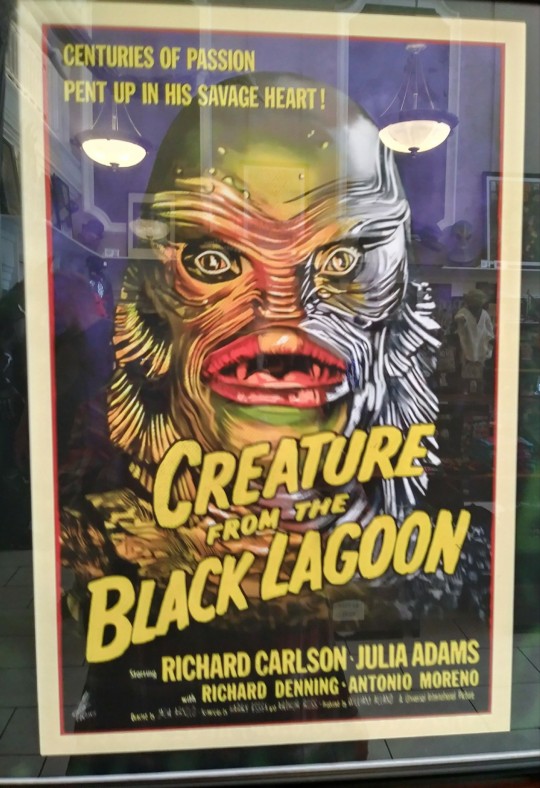
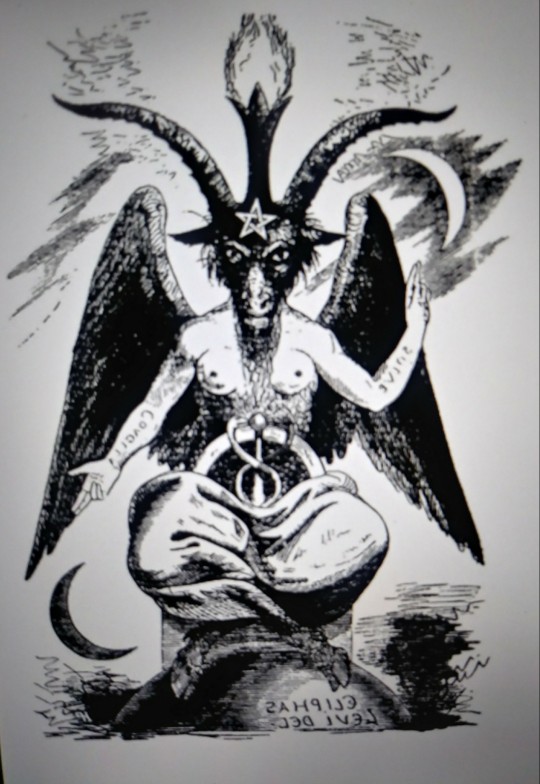
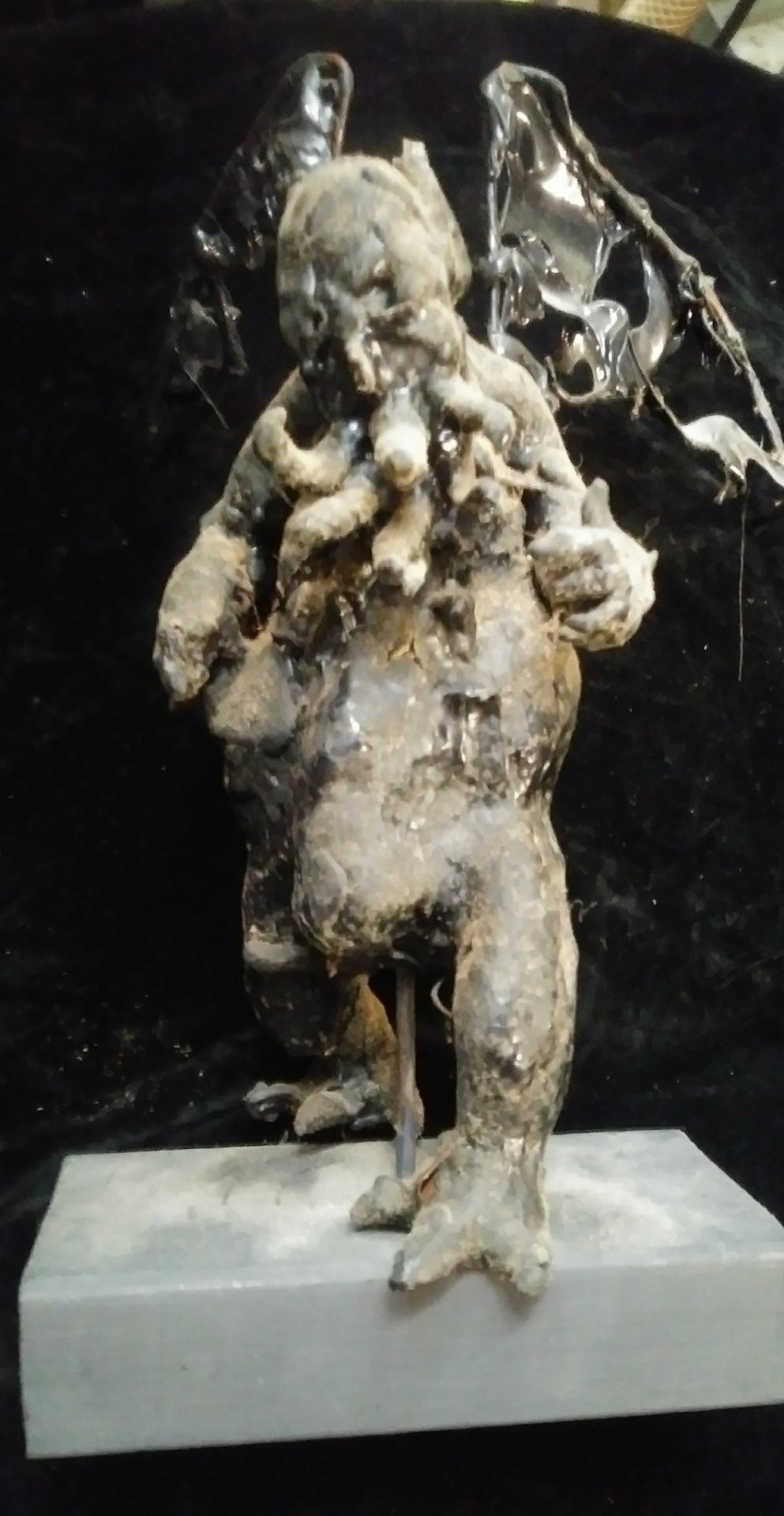


17 notes
·
View notes
Video
Common (Crucibulum laeve) and Fluted (Cyathus striatus) Bird's Nest Fungi by Will Atkins Via Flickr: (Common on the left, fluted on the right)
#Bird's Nest Fungi#Bird's Nest Fungus#Crucibulum#laevem#Cyathus#Cyathus striatus#European Fungi#Fungi#Fungi of Europe#British Fungi#Fungi of Britain#mushroom#mushrooms#toadstool#toadstools#UK Fungi#Fungi of the UK#London Fungi#Fungi of London#woodland Fungi#leaf litter#Wildlife#Wildlife of Europe#European Wildlife#Nature#Nikon#Nikon D850#Laowa#Laowa 100mm#Laowa 2X macro
6 notes
·
View notes
Text

Found and photographed on a mountain biking trail in West Virginia
ID by, me: Pleated Inkcap
Life is fleeting, especially for this mushroom. It's body disappears in under 24 hours.
See more photos, and learn more about the pleated Inkcap below the cut!


The pleated Inkcap grows at night after rain, it has to spread its spores fast, and like a vampire this mushroom does not fare well in sunlight.
After sprouting, it grows to full size within hours releases its spores, then consumes itself. Quickly self decomposing to gather as much nutrients from its fruiting body as it can before the sun dries it out.
It's fruiting body short lived but beautiful, this fungi continues on strong through its mycelium underground, waiting patiently for the next rainfall.
Medicinal uses are unknown.
Edibility: inedible
Rarity: common
Genus: Parasola
Regions: Britain, Ireland, Mainland Europe, & North America
Please do your own research, I am an enthusiast not a scientist. I'm here to share and have fun.
All photographs taken by me:
Toast Loafley/Juno S.
#mushrooms#wild fungi#fungi#photography#nature#nature photography#mushroom identification#ToastLoafley
33 notes
·
View notes
Text
My Great British Wild Year: Part 4 of 5-Flowers and fungi
Spring scurvygrass of Scottish shores, magical marsh helleborine at Anglesey’s Newborough and the splendour of snake’s-head fritillaries at Lakeside Country Park at home were three of the highlights of my wildflower year. It was an awesome orchid year for me, as we went into summer I was treated to a fair few exquisite bee orchids at Lakeside, RSPB Conwy and Durlston and especially at Lakeside pyramidal orchids glowed in ethereal mystique. Two big orchid finds of my year came at Martin Down, on a day we also marvelled at the burnt-tip orchids we’ve seen there so much I was elated to see my first ever butterfly orchid in late May, and earlier that month we saw stunning white form early purple orchids a familiar flower for us which we enjoyed immensely there and at Noar Hill in May. Heath and common spotted orchid were stars for me this year too and I did well for marsh orchids including a beautiful early marsh orchid at Newborough.
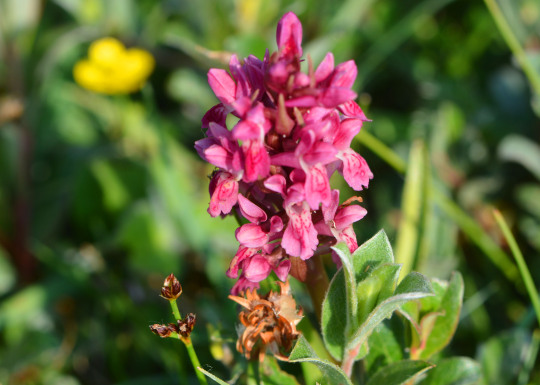
The early marsh orchid

The butterfly orchid
Winter heliotrope captivated me from the very start of the year on New Year’s Day at Lakeside enjoying them late in the year too as it came full circle, and lesser celandine this year in England and Scotland will always remind me of one of my greatest springs. My first ever greater celandine at Lakeside stood out, with mysterious wood anemone and greater and lesser stitchwort, shiny speedwells, prominent red campion, fascinating bugle, shining bird’s-foot trefoil and delicate snowflakes other standout species of my year. The Anglesey week was a floral fest with English stonecrop, yellow horned poppy which I saw at Hill Head later in the summer too, thrift, sheep’s-bit, kidney vetch, enigmatic marsh cinquefoil, possible wild pansy and sumptuous restharrow other standout species. Centaury and common toadflax, two of my favourites, were ones I got excited about many times this year. Into summer and red bartsia, purple loosestrife, hemp agrimony, great willowherb, precious water mint, colourful bird or tufted vetch, wild basil, marjoram, common and bell heather and cross-leaved heath in a strong New Forest summer of purple heather, harebell, eyebright, knapweed, revelations of my year mugwort, gypsywort and lady’s thumb aka redshank and fleabane a star of my summer stood out. Another of my finds of the year was rare cut-leaved self-heal at Shipton Bellinger. A late summer/autumn favourite of mine I was taken by again was enigmatic devil’s-bit scabious. Marsh mallow at Minsmere in a strong mallow year I had and round-leaved sundew at Thursley were September greats of my year. Foxgloves, tansy and comfrey were other highlights. In late summer and autumn a bumper berry crop transformed the landscape, with hawthorn, rose hips, holly and guelder rose berries in particular creating a scarlet cloak.
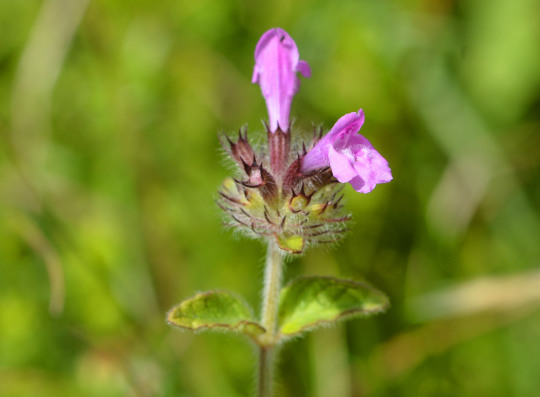
Wild basil at Shipton Bellinger
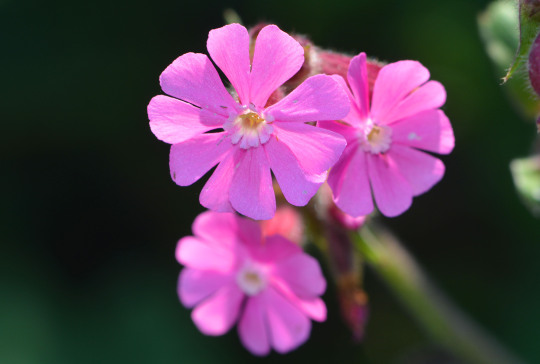
Red campion at RSPB Cors Ddyga
In late winter/spring I saw amazing scarlet elf cup a fair few times firstly enchanting the woods of RSPB Titchwell and then at home in Hampshire, I love the colour and shape of this mushroom. It was thrilling to see both devil’s fingers and nail fungus (Poronia punctata) near Bolton’s Bench in the New Forest in September and October, otherworldly and enigmatic shrooms. That day in October I was also stunned to see many fly agaric there, iconic ruby mushrooms which is the species that first got me into them. Also that day at Denny Wood in the New Forest I was overjoyed to see a few delicate, neat and some nanoscopic amethyst deceivers, fine mushrooms as though woven in purple silk as well as bold bleeding fairy helmet. I saw fly agaric and amethyst deceiver especially the latter in a fest for them multiple times in the forest this autumn. Turkey tail, eyelash fungus at Bentley Wood in spring, shaggy ink caps, common ink caps, pleated ink cap, alluring and cosy shaggy scalycaps, yellow stagshorn, mysterious candlesnuff fungi, my first ever white spindles a lovely one, parasol, sulphur tuft, panthercap, some gratifying hoof fungus at RSPB Loch Ruthven which became evocative of the Scotland trip, common puffball and lots of common earthball were other highlights this year.
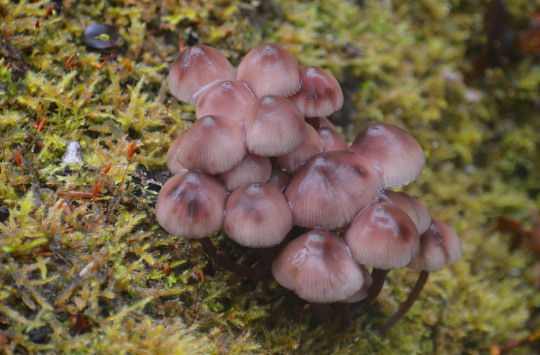
The Denny Wood bleeding fairy helmets

Fly agaric at Bolton's Bench
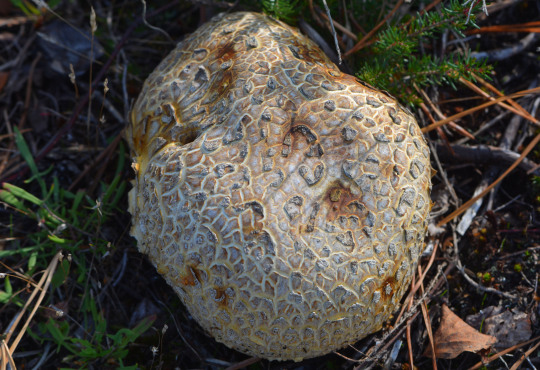
Earthball at Thursley

Amethyst deceivers on a walk from Cadman's Pool in the New Forest
#england#scotland#wales#photography#flowers#plants#fruit#mushrooms#fungi#uk#outdoors#walking#britain#winter#spring#autumn#summer#colourful#red campion#early purple orchid#early marsh orchid#fleabane#fly agaric#scurvygrass#bee orchid#snake's-head fritillary#foxgloves#bleeding fairy helment#2023#memories
1 note
·
View note
Text

Under the radar
The fight for a fungi future
Fungi could be classified alongside animals and plants as a separate realm for environmental protection, under plans drawn up by Britain and Chile for a United Nations conference on biodiversity wrapping up this week. The plan calls for "funga" to be granted a global legal consideration distinct from flora and fauna. Experts say that could change the future path of the planet. The Fungal Conservation Pledge, which has been submitted to the U.N. convention on biological diversity at its Cop16 conference in Colombia, argues for the "recognition of fungi" as an "independent kingdom of life in legislation, policies and agreements" to "advance their conservation." The pledge urges signatory nations to "adopt concrete measures" that "allow for maintaining their benefits" to ecosystems and people. Chile and Britain collaborated on the declaration with the Fungi Foundation, a nonprofit conservation group that has been working for 12 years to "integrate fungi into the highest levels of conservation policy and legislation." As ever, money is at the heart of the issue. Although fungi represent "16 times more of Earth's biodiversity than plants," conservation efforts receive "less than a third of the funding that plant research does," Dr Toby Kiers, chief scientist at the Society for the Protection of Underground Networks, told Forbes. The variety among fungi is "remarkable" and "far wider" than the diversity that exists among plants and vertebrates, according to National Geographic. The organisms are "in us, on us and all around us," and the growing effort to "study and protect our fungal neighbors" may define our "intertwined futures."
4 notes
·
View notes
Text
Omphalotus illudens (Jack ‘o’ Lantern) (Mushrooms) (Wild Mushrooms) (Horticulture)







Photos taken in the garden at home in Northumberland, UK.
Photos by @warrenwoodhouse #warrenwoodhouse
Camera: iPhone XR (Product Red)
Date & Time: 12th November 2023 at 6:47 pm
Fungi: Omphalotus illudens (Jack ‘o’ Lantern)
Fungi Description: Rare fungi plant that is native to Britain. Grows and is visible between mid November to early December. It’s toxic and must be handled with gloves, a mask covering your mouth and gardening glasses for protecting your eyes. Do not ingest or touch.
Is it poisonous?: Yes. Symptoms include watery diarrhoea, stomach aches, mild headaches, nausea and mild vomiting. These symptoms may last for at least a day to as long as two full weeks.
Location: Home, Northumberland, UK.
Additional Information: CLICK HERE to learn more about the fungi plant
#warrenwoodhouse#2023#gardening#garden#wild fungi#fungi#horticulture#mushroom#mushrooms#wild mushrooms#wild mushroom#only in the uk#uk#northumberland#poisonous mushrooms#poisonous mushroom#jack ‘o’ lantern#jack o lantern#iphonography#photos#photography#photographers on tumblr#warrenwoodhousephotos#rare mushroom#rare mushrooms#Omphalotus illudens#botany#horticultureblog#gardeningblog#mycology
10 notes
·
View notes
Video
Nature's Woodland Decay - Scarlet Cup Fungi by Adam Swaine Via Flickr: SCARLET ELF CUP (Sarcoscypha austriaca)..Mystical and cheery, the scarlet elf cup grows on decaying sticks and branches in damp spots and beneath leaf litter on the woodland floor. Their bright pops of colour brighten up even the darkest winter day.Elf cup fungus is fairly widespread but uncommon in Britain and Ireland. It favours areas with high rainfall and can be seen on decaying sticks and branches – especially in damp areas of the woodland floor – and on ditch sides and stream banks.
#woodland#woodland floor#moss#fungi#leaves#WINTER#natures finest#nature#nature lovers#nature reserve#warnham#england#english#britain#british#West Sussex#sussex#uk#uk counties#countryside#counties#seasons#Adam Swaine#fuji#2024#walks#flora#wild#South East#rural
1 note
·
View note